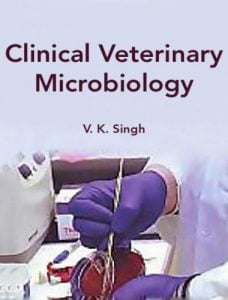Clinical Veterinary Microbiology 1st Edition
by V. K. Singh
Veterinary Microbiology is concerned with microbial diseases of domesticated animals that supply food, other
 useful products or companionship. We also know that microorganisms may have one or more of four functions in a food. They may have a useful function, cause spoilage, be a health hazard, or just be present without a role in the food item.
useful products or companionship. We also know that microorganisms may have one or more of four functions in a food. They may have a useful function, cause spoilage, be a health hazard, or just be present without a role in the food item.
Microbial disease must be understood in terms of the interrelationship among parasites, the host, and the environment. For example, the general health of the host may determine whether a disease occurs and how severe it may be. Even though a microorganism may be part of the ordinary flora, it can cause disease if the host’s natural defences are not fully effective.
This book Clinical Veterinary Microbiology 1st Edition is a complete reference guide on microbial biology, diseases, diagnosis, prevention, and control. It also provides a foundation of knowledge on pathogens and how they interact with hosts. The book offers essential information for veterinary students, clinicians, technicians, public health officials, and diagnostic microbiologists.
Veterinary Microbiology is concerned with microbial (bacterial, fungal, viral) diseases of domesticated animals (livestock, companion animals, fur-bearing animals, game, poultry, and fish) that supply food, other useful products or companionship. We also know that microorganisms may have one or more of four functions in a food. They may have a useful function, cause spoilage, be a health hazard, or just be present without a role in the food item.
Microbial disease must be understood in terms of the interrelationship among parasites, the host, and the environment. For example, the general health of the host may determine whether a disease occurs and how severe it may be. Even though a microorganism may be part of the ordinary flora, it can cause disease if the host’s natural defences are not fully effective. Parasites that usually cause disease are called pathogens, and pathogenicity is the term used to denote disease-producing ability.
Download: Veterinary Microbiology 3rd Edition PDF
Virulence denotes the degree of pathogenicity, it is used to describe a particular strain or variety of a species. Pathogenicity or virulence may be due to the bacteria’s invasiveness or toxigenicity. By invasiveness is meant the ability of the bacteria to enter, spread, and multiply in host tissue. Although it is not always easy to obtain optimal specimens when working with animals, certain practices can ensure the best possible specimen under the circumstances.
-
- Book Name: Clinical Veterinary Microbiology 1st Edition
- File Type: PDF
- Download: Link
- Size: 9 MB
- Password: PDFLibrary.Net


5